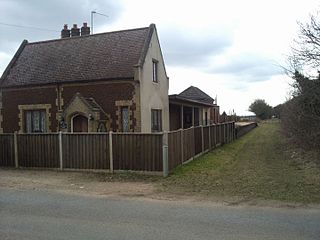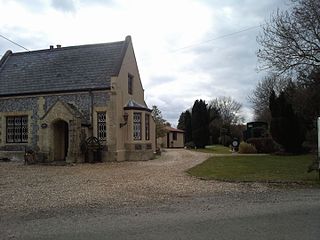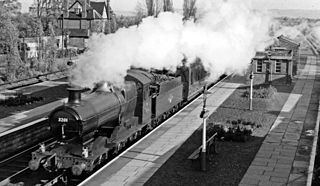Related Research Articles

New Cross Gate is a railway station in New Cross, London, on the Brighton Main Line and the London Overground. It is 2 miles 70 chains (4.63 km) down the line from London Bridge and is about 600 m (660 yd) west of New Cross station. It is in Travelcard Zone 2, and is operated by London Overground.

Reedham railway station is on the Wherry Lines in the East of England, serving the village of Reedham, Norfolk. It is 12 miles 13 chains (19.6 km) down the line from Norwich and is situated between Cantley to the west and, to the east, Berney Arms on the Great Yarmouth branch or Haddiscoe on the Lowestoft branch. It is commonly suffixed as Reedham (Norfolk) in order to distinguish it from the station of the same name in south London. Its three-letter station code is REE.

Watlington railway station is on the Fen line in the east of England, serving the village of Watlington, Norfolk. It is 90 miles 70 chains (146.2 km) measured from London Liverpool Street and is situated between Downham Market and King's Lynn stations. Its three-letter station code is WTG.

Narborough railway station serves the villages of Narborough and Littlethorpe in Leicestershire. It is on the Birmingham to Peterborough Line about 7 miles (11 km) southwest of Leicester. The station is owned by Network Rail and managed by East Midlands Railway, who do not serve the station. Only CrossCountry trains serve the station.

Bury St Edmunds railway station serves the town of Bury St Edmunds in Suffolk, England. The station is on the Ipswich–Ely line and all trains calling there are operated by Greater Anglia.
The Lanarkshire and Dumbartonshire Railway was a railway company in Scotland. It was promoted independently but supported by the Caledonian Railway, and it was designed to connect Balloch and Dumbarton with central Glasgow, linking in heavy industry on the north bank of the River Clyde. From Dumbarton to Balloch the line would have closely duplicated an existing railway, and negotiation led to the latter being made jointly operated, and the L&DR terminated immediately east of Dumbarton, trains continuing on the joint section.

Corwen railway station was a railway station on the Ruabon to Barmouth Line, located in the town of Corwen in Denbighshire, Wales.

Hethersett was a railway station near Hethersett, Norfolk.

Denver railway station was a station in Denver, Norfolk on the Great Eastern Railway route between King's Lynn and Cambridge, commonly known as the Fen Line. It was also the beginning of a small branch to Stoke Ferry.

Middleton Towers railway station was a station in Middleton, Norfolk. It was on the line between Swaffham and King's Lynn, and closed along with the rest of the line in 1968.

East Winch railway station was at East Winch, Norfolk, England on the line between King's Lynn and Swaffham. It closed in 1968.

Narborough and Pentney station was in Norfolk, serving the villages of Narborough and Pentney.

Fransham railway station is a former station in Great Fransham, Norfolk. It was opened as part of the Lynn and Dereham Railway, becoming part of the East Anglian Railway from 1847, on the section of line between Dereham and Swaffham.

Churchdown railway station was situated on the main line between Gloucester and Cheltenham Spa. It served Churchdown and surrounding areas.
The Lynn and Dereham Railway was a standard gauge 26 1⁄2-mile (42.6 km) single track railway running between King's Lynn and Dereham in the English county of Norfolk. The Lynn to Dereham line opened in 1846 and closed in 1968, although the section between Middleton Towers and King's Lynn remains open to freight.

St. Germain's railway station was located on the line between Kings Lynn and Watlington. It served the parish of Wiggenhall St. Germans, and closed in 1850.
Sporle railway station was located on the line between Swaffham and Dunham. It opened with the line in 1847 and was temporarily the terminus of the line from Swaffham while building works were being completed towards Dereham. The station served the parish of Sporle with Palgrave and was short-lived - the station closed three years after opening in 1850.
Ouse Bridge railway station was a railway station in Norfolk, England.
Ipswich Stoke Hill railway station was the northern terminus of the Eastern Union Railway line from Colchester to Ipswich from its opening in June 1846 until 1860 when the present Ipswich station opened at the other end of the Stoke tunnel. Trains from London terminated at the station but from November 1846 when a new line was built by the Ipswich and Bury Railway to Bury St Edmunds trains from Bury used to pass the station, stop at Halifax Junction a short distance to the south and propel back into the terminus usually using the western platform. Trains for Bury would reverse out as far as Halifax Junction before travelling north.

Narborough Railway Line or Narborough Railway Embankment is a 7.9-hectare (20-acre) biological Site of Special Scientific Interest south-east of King's Lynn in Norfolk. It is a former railway embankment which is now a nature reserve managed by the Norfolk Wildlife Trust. It is 1 kilometre (0.62 mi) south of Narborough, on the A47 going east from King's Lynn to Swaffham, and it can be entered by a car park west of the reserve. It was documented in 1847 as an area with much chalk and flints.
References
- 1 2 Butt, R. V. J. (1995). The Directory of Railway Stations: details every public and private passenger station, halt, platform and stopping place, past and present (1st ed.). Sparkford: Patrick Stephens Ltd. ISBN 978-1-85260-508-7. OCLC 60251199.
- ↑ Dewick, Tony (2002). Complete Atlas of Railway Station Names. Ian Allan. ISBN 0-7110-2798-6.
- ↑ C.J. Allen [ full citation needed ]